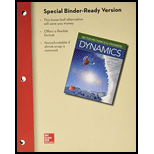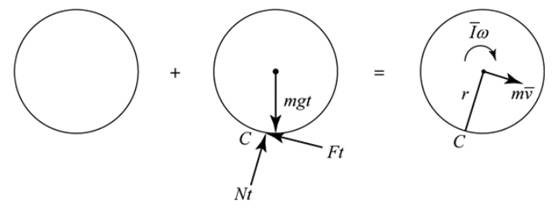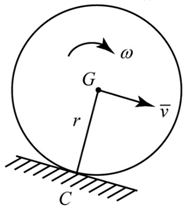
Concept explainers
(a)
The velocity of the wheel’s center at time t.
Answer to Problem 17.70P
Velocity of wheel center at time t will be,
Explanation of Solution
Given:
Wheel is initially at rest and it is relased from an indined surface from rest.

Wheel radius is
The radius of gyration of the wheel is
Initial velocity
Concept used:
Impulse momentum principle,
Moment of inertia
Assume rolling of the wheel without sliding
According to theimpulse-momentum principle,

Taking moment about the point of contact C,

Considering the rolling motion of the wheel,
also a moment of inertia,
putting values in equation (1),
Conclusion:
In this way we can calculate the velocity of the wheel at time t by the impulse-momentum principle and simple calculation,
(b)
The coefficient of static friction needed to overcome the slipping of the wheel.
Answer to Problem 17.70P
Coefficient of friction between wheel and surface needed to overcome slipping of the wheel is
Explanation of Solution
Given:
Wheel radius is
The radius of gyration of the wheel is
Initial velocity
Concept used:
Impulse momentum principle,
Moment of inertia
Assume rolling of the wheel without sliding
Parallel component of inclination
The normal component of indignation
As we know thsat, the coefficient of friction is the ratio of force to the normal reaction between the two objects.
Thus we have,
Conclusion:
Hence, by calculating the normal and parallel component of indignation, we get the value of the coefficient of friction between wheel and slope is
Want to see more full solutions like this?
Chapter 17 Solutions
Package: Vector Mechanics for Engineers: Dynamics with 2 Semester Connect Access Card
- The rotor of an electric motor has an angular velocity of 4500 rpm when the load and power are cut off. The 75-kg rotor, which has a centroidal radius of gyration of 200 mm, then coasts to rest. Knowing that kinetic friction results in a couple of magnitude 4.5 Nm. exerted on the rotor, determine the number of revolutions that the rotor executes before coming to rest.arrow_forwardThe rotor of an electric motor has an angular velocity of 3600 rpm when the load and power are cut off. The 110-lb rotor, which has a centroidal radius of gyration of 9 in., then coasts to rest. Knowing that the kinetic friction of the rotor produces a couple with a magnitude of 2.5 1b.ft determine the number of revolutions that the rotor executes before coming to rest.arrow_forwardThe 10-in.-radius brake drum is attached to a larger flywheel which is not shown. The total mass moment of inertia of the flywheel and drum is 22 lb ⋅ ft ⋅ s 2 and the coefficient of kinetic friction between the drum and the brake shoe is 0.41. Knowing that the initial angular velocity is 255 rpm clockwise, determine the force which must be exerted by the hydraulic cylinder at point B if the system is to stop in 85 revolutions. determine the force which must be exerted by the hydraulic cylinder at point B if the system is to stop in 85 revolutions. DO NOT ROUND OFF IN THE SOLUTION. ROUND OFF ONLY IN 2 DECIMAL PLACE IN THE FINAL ANSWER.arrow_forward
- The 8-in. radius brake drum is attached to a larger flywheel that is not shown. The total mass moment of inertia of the drum and the flywheel is 15 lb.ft.s2 and the coefficient of kinetic friction between the drum and the brake shoe is 0.40. Knowing that the angular velocity of the flywheel is 450 rpm clockwise when a force P of magnitude 65 lbf. is applied to the pedal C, determine the number of the revolutions executed by the flywheel before it comes to rest. (The final answer should be in two decimal places with correct units)arrow_forwardA long ladder of length l, mass m, and centroidal mass moment of inertia I is placed against a house at an angle 0=0O. Knowing that the ladder is released from rest, determine the angular velocity of the ladder when 0=02. Assume the ladder can slide freely on the horizontal ground and on the vertical wall.arrow_forwardThe rotor of an electric motor has an angular velocity of 3600 rpm when the load and power are cut off. The 120-lb rotor, which has a centroidal radius of gyration of 9 in., then coasts to rest. Knowing that kinetic friction results in a couple of magnitude 2.5 lb·ft exerted on the rotor, determine the number of revolutions that the rotor executes before coming to rest.arrow_forward
- A cylinder of radius r and weight W with an initial counterclockwise angular velocity w0 is placed in the corner formed by the floor and a vertical wall. Denoting by μk the coefficient of kinetic friction between the cylinder and the wall and the floor, derive an expression for the time required for the cylinder to come to rest.arrow_forwardA 200-kg flywheel is at rest when a constant 300 N.m couple is applied. After executing 560 revolutions, the flywheel reaches its rated speed of 2400 rpm. Knowing that the radius of gyration of the flywheel is 400 mm, determine the average magnitude of the couple due to kinetic friction in the bearing.arrow_forwardA slender rod with a length of L and weight W is attached to a collar at A and is fitted with a small wheel at B . Knowing that the wheel rolls freely along a cylindrical surface of radius R , and neglecting friction, derive an equation in 0, L, and R that must be satisfied when the rod is in equilibrium.arrow_forward
- The mechanism shown is one of two identical mechanisms attached to the two sides of a 200-lb uniform rectangular door. Edge ABC of the door is guided by wheels of negligible mass that roll in horizontal and vertical tracks. A spring with a constant k is attached to wheel B in such a way that its tension is zero when 0 = 30°, Knowing that the door is released from rest in the position 0 = 45° and reaches the vertical position with an angular velocity of 0.6 rad/s, determine the spring constant k.arrow_forwardThe rotor of an electric motor has a mass of 25 kg, and it is observed that 4.2 min is required for the rotor to coast to rest from an angular velocity of 3600 rpm. Knowing that kinetic friction produces a couple of magnitude 1.2 N.m, determine the centroidal radius of gyration for the rotor.arrow_forwardThe 80-mm-radius gear shown has a mass of 5 kg and a centroidal radius of gyration of 60 mm. The 4-kg rod AB is attached to the center of the gear and to a pin at B that slides freely in a vertical slot. Knowing that the system is released from rest when 0 = 60°, determine the velocity of the center of the gear when 0 = 20°.arrow_forward
 Elements Of ElectromagneticsMechanical EngineeringISBN:9780190698614Author:Sadiku, Matthew N. O.Publisher:Oxford University Press
Elements Of ElectromagneticsMechanical EngineeringISBN:9780190698614Author:Sadiku, Matthew N. O.Publisher:Oxford University Press Mechanics of Materials (10th Edition)Mechanical EngineeringISBN:9780134319650Author:Russell C. HibbelerPublisher:PEARSON
Mechanics of Materials (10th Edition)Mechanical EngineeringISBN:9780134319650Author:Russell C. HibbelerPublisher:PEARSON Thermodynamics: An Engineering ApproachMechanical EngineeringISBN:9781259822674Author:Yunus A. Cengel Dr., Michael A. BolesPublisher:McGraw-Hill Education
Thermodynamics: An Engineering ApproachMechanical EngineeringISBN:9781259822674Author:Yunus A. Cengel Dr., Michael A. BolesPublisher:McGraw-Hill Education Control Systems EngineeringMechanical EngineeringISBN:9781118170519Author:Norman S. NisePublisher:WILEY
Control Systems EngineeringMechanical EngineeringISBN:9781118170519Author:Norman S. NisePublisher:WILEY Mechanics of Materials (MindTap Course List)Mechanical EngineeringISBN:9781337093347Author:Barry J. Goodno, James M. GerePublisher:Cengage Learning
Mechanics of Materials (MindTap Course List)Mechanical EngineeringISBN:9781337093347Author:Barry J. Goodno, James M. GerePublisher:Cengage Learning Engineering Mechanics: StaticsMechanical EngineeringISBN:9781118807330Author:James L. Meriam, L. G. Kraige, J. N. BoltonPublisher:WILEY
Engineering Mechanics: StaticsMechanical EngineeringISBN:9781118807330Author:James L. Meriam, L. G. Kraige, J. N. BoltonPublisher:WILEY





